预应力混凝土结构PrestressedConcreteStructure
- 格式:ppt
- 大小:746.50 KB
- 文档页数:5
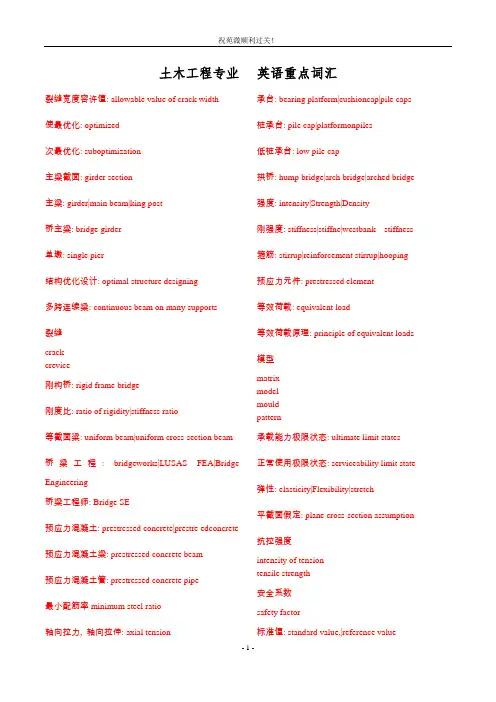
土木工程专业裂缝宽度容许值: allowable value of crack width使最优化: optimized次最优化: suboptimization主梁截面: girder section主梁: girder|main beam|king post桥主梁: bridge girder单墩: single pier结构优化设计: optimal structure designing多跨连续梁: continuous beam on many supports裂缝crackcrevice刚构桥: rigid frame bridge刚度比: ratio of rigidity|stiffness ratio等截面粱: uniform beam|uniform cross-section beam 桥梁工程: bridgeworks|LUSAS FEA|Bridge Engineering桥梁工程师: Bridge SE预应力混凝土: prestressed concrete|prestre edconcrete 预应力混凝土梁: prestressed concrete beam预应力混凝土管: prestressed concrete pipe最小配筋率minimum steel ratio轴向拉力, 轴向拉伸: axial tension英语重点词汇承台: bearing platform|cushioncap|pile caps桩承台: pile cap|platformonpiles低桩承台: low pile cap拱桥: hump bridge|arch bridge|arched bridge强度: intensity|Strength|Density刚强度: stiffness|stiffne|westbank stiffness箍筋: stirrup|reinforcement stirrup|hooping预应力元件: prestressed element等效荷载: equivalent load等效荷载原理: principle of equivalent loads模型matrixmodelmouldpattern承载能力极限状态: ultimate limit states正常使用极限状态: serviceability limit state 弹性: elasticity|Flexibility|stretch平截面假定: plane cross-section assumption抗拉强度intensity of tensiontensile strength安全系数safety factor标准值: standard value,|reference value作用标准值: characteristic value of an action重力标准值: gravity standard设计值: design value|value|designed value作用设计值: design value of an action荷载设计值: design value of a load可靠度: Reliability|degree of reliability不可靠度: Unreliability高可靠度: High Reliability几何特征: geometrical characteristic塑性plastic natureplasticity应力图: stress diagram|stress pattern压应力: compressive stress|compression stress配筋率: reinforcement ratio纵向配筋率: longitudinal steel ratio有限元分析: FEA|finite element analysis (FEA)|ABAQUS有限元法: finite element method线性有限元法: Linear Finite Element Method裂缝控制: crack control控制裂缝钢筋: crack-control reinforcement应力集中: stress concentration主拉应力: principal tensile stress非线性nonlinearity非线性振动: nonlinear vibration弯矩: bending moment|flexural moment|kN-m弯矩图: bending moment diagram|moment curve弯矩中心: center of moments|momentcenter剪力: shearing force|shear force|shear剪力墙: shear wall|shearing wall|shear panel弹性模量elasticity modulus剪力图: shear diagram|shearing force diagram剪力和弯矩图: Shear and Moment Diagrams剪力墙结构: shear wall structure轴力: shaft force|axial force框架结构frame construction板单元: plate unit曲率curvature材料力学mechanics of materials结构力学: Structural Mechanics|theory of structures 弯曲刚度: bending stiffness|flexural rigidity截面弯曲刚度: flexural rigidity of section弯曲刚度,抗弯劲度: bending stiffness钢管混凝土结构: encased structures极限荷载: ultimate load极限荷载设计: limit load design|ultimate load design 板壳力学: Plate Mechanic主钢筋: main reinforcement|Main Reinforcing Steel 钢筋混凝土的主钢筋: main bar悬臂梁: cantilever beam|cantilever|outrigger悬链线: Catenary,|catenary wire|chainetteribbed stiffener加劲肋: stiffening rib|stiffener|ribbed stiffener短加劲肋: short stiffener支承加劲肋: bearing stiffener技术标准technology standard水文: Hydrology招标invite public bidding连续梁: continuous beam|through beam多跨连续梁: continuous beam on many supports wind resistance抗风: Withstand Wind |wind resistance基础的basal初步设计predesignpreliminary plan技术设计: technical design|technical project施工图设计: construction documents design基础foundationbasebasis 结构形式: Type of construction|form of structure屋顶结构形式: roof form地震earthquake地震活动: Seismic activity|seismic motion耐久性: durability|permanence|endurance耐久性试验: endurance test|life test|durability test短暂状况: transient situation偶然状况: accidental situation永久作用: permanent action永久作用标准值: characteristic value of permanent action可变作用: variable action可变作用标准值: characteristic value of variable action可变光阑作用: iris action偶然作用: accidental action作用效应偶然组合: accidental combination for action effects作用代表值: representative value of an action作用标准值: characteristic value of an action地震作用标准值: characteristic value of earthquake action可变作用标准值: characteristic value of variable action作用频遇值Frequent value of an action安全等级: safety class|Security Level|safeclass设计基准期: design reference period作用效应: effects of actions|effect of an action作用效应设计值Design value of an action effect分项系数: partial safety factor|partial factor作用分项系数: partial safety factor for action抗力分项系数: partial safety factor for resistance作用效应组合: combination for action effects结构重要性系数Coefficient for importance of a structure桥涵桥涵跟桥梁比较类似,主要区别在于:单孔跨径小于5m或多孔跨径之和小于8m的为桥涵,大于这个标准的为桥梁水力: hydraulic power|water power|water stress跨度span人行道sidewalk无压力: stress-free净高clear height矩形rectangle无铰拱: arch without articulation|fixed end arch荷载load荷载强度: loading intensity|loading inte ity荷载系数: load factor|loading coefficient桥头堡bridgeheadbridge tower美观pleasing to the eyebeautifulartistic经济的economicaloecumenicaleconomic适用be applicable防水waterproof剪切模量: shear modulus|rigidity modulus|GXY剪切强度: shear strength|shearing strength|Fe-Fe扭转剪切强度: torsional shear strength剪切破坏: shear failure|shear fracture|shear damage 纯剪切破坏: complete shear failure局部剪切破坏: local shear failure永久冻土: permafrost|perennial frost土的侧压力: earth lateral pressure收缩shrinkpull backcontract徐变: creep摩擦系数: coefficient of friction|friction factor风荷载: wind load|wind loading风荷载标准值: characteristi cvalue of windload 风荷载体型系数: shape factor of windload温度作用: temperature action支座: support|bearing|carrier 外支座: outer support|outersu ort代表值: central value|representative value结构自重: self-weightstructure|dead load最不利分布: Least favorable distribution,抗震antiknockquake-proofearthquake proofing constructionearthquake-resistanceearthquake proof钢结构steel structure钢结构设计: Design Of Steel Structure钢结构设计规范: Code for design of steel structures 混凝土结构设计规范: Code for design of concrete structures预应力混凝土结构设计软件: PREC温度梯度: temperature gradient|thermal gradient动力系数: dynamic coefficient制动力系数: Braking force coefficient动力学kineticsdynamicsdyn内摩擦角: angle of internal friction有效内摩擦角: effective angle of internal friction主效应main effect主效应: Main effect,主效应模型: Main effect model超静定的: hyperstatic超静定结构: statically indeterminate structure静定: statically determinate静定梁: statically determinate beam附属设备: accessories|accessory equipment稳定系数: coefficient of stabilizationearth pressure at rest静土压力: earthpressureatrest挡土墙retaining wallabamurus主动土压力: active earth pressure被动土压力: passive earth pressure土层soil horizon土层剖面: soil profile土层剖面特性: soil-profile characteristics密度densitythickness宽度width净距: clear distance|gabarit|Clearance钢筋强度标准值: characteristic value of strength of steel bar钢材强度标准值: characteristic value of strength of steel折减系数: reduction factor|discount coefficient强度折减系数: strength reduction factor线性linearity线性代数linear algebra位移displacement位移角: angle of displacement|angle of slip应变量: dependent variable|strain capacityuniform stress均布应力: uniform stress非均布应力: non-uniform stress均布荷载: uniformly distributed load集中荷载: concentrated load|point load可变集中荷载: variable concentrated load法向集中荷载: normal point load影响线: influence line反力影响线: influence line for reaction影响线方程: equation of the influence line车辆荷载: car load|vehicular load|traffic load计算跨径: calculated span重力加速度: acceleration of gravity膨胀系数: coefficient of expansion|expansivity术语termterminology恒载: dead load|deadloading|permanent load活载: live load楼面活载: floor live load概率分布: probability distribution 联合概率分布: Joint probability distribution,边缘概率分布: Marginal probability distribution,拱腹: soffit|intrados|arch soffit三铰拱: three hinged arch土木工程系: Department of Civil Engineering土木工程师协会: ICE土木工程师协会: Institute of Civil Engineers作用准永久值: quasi-permanentvalueofanaction 直径diameter验算: checking|check calculation验算公式: check formula变形验算: deformation analysis建筑材料tignum刚度rigidityseveritystiffness单元: cell|Unit|module节点node位移方程式: strain displacement equation三维three dimensional 3d插值: Interpolation|interpolate|Spline插值法: interpolation|method of interpolation轴对称axial symmetryrotational symetryaxisymmetric(al)应变矩阵strain matrix应变矩阵: strain matrix单元应变矩阵: element strain matrix应力应变矩阵: stress-strainmatrix阻尼矩阵: damping matrix|daraf|damped matrix 弹性系数矩阵: elastic coefficient matrix雅可比矩阵: Jacobi matrix|jacobian matrix刚度矩阵: stiffness matrix|rigidity matrix质量矩阵: mass matrix|ma matrix节点力: nodal forces等效节点力: equivalent nodal force节点荷载: joint load|nodal loads节点荷载: joint load|nodal loads一致节点荷载: consistent nodal load应力矩阵: stress matrix挠度: deflection|flexivity|flexure转角: corners|intersection angle|rotor angle单元刚度矩阵: element stiffness matrix边界条件: boundary condition|edge conditions疲劳强度: fatigue strength|endurance strength抗疲劳强度: fatigue resistance工程局: construction bureau沉井基础: open caisson foundation水泥cement水泥砂浆cement mortar石膏: Gypsum|plaster|Plaster of Paris简支梁: simply supported beam|simple beam简支梁桥: simple supported girder bridge平衡条件: equilibrium condition|balance condition约束条件: constraint condition|constraint数值解: numerical solution|arithmeticsolution力法: force method|brute force method位移法: displacement method|di lacement method力矩分配法: moment distribution method|moment diagram理论力学: Theoretical Mechanics弹性力学: Theory of Elastic Mechanics结构动力学: Structural Dynamics|Clough高等结构动力学: Advancd Dynamics of Structures测量学: surveying|metrology|geodesy道路工程: road works|highway construction铁路工程: railway engineering|rairoad engineering隧道: Tunnels|subway|underpass轨道: orbit|track|trajectory砂子: sand抗压强度pressive strength焊接技术: Welding Engineering Technology (WET)断裂力学: Fracture Mechanics|fracturing mechanics基础工程: foundation engineering|foundation works 地质学: geology|die Geologie, opl.|geognosy岩土力学: rock mechanics|rock-soil mechanics工程力学: engineering mechanics轴线axes拱脚: arch springing|abutment|spring木桥: timber bridge|wodden bridge|Woodbridge枕木sleeper crosstie残余应力: residual stress|remaining stress 复合应力: combined stress|compound stress初始应力: initial stress|primary stress屈服极限: yield limit|minimum yield|yield strength疲劳屈服极限: fatigue yield limit应力幅值: stress amplitude冲击韧性: impact toughness|Impelling strength反弯点: knick point|pointofcontraflexure桁架: truss|tru|Girder网架结构: space truss structure|grid structure锚孔: anchor eye大跨度: High-span柱: column|pillar|Clmn. Coloumn常微分方程: Ordinary Differentical Equations|ODE|ODEs增大系数: enhancementcoefficient浮桥flying bridge raft bridgepontoon bridge pontoonfloat bridge浮桥: pontoon bridge|pontoon|floating bridge轮渡: Ferry|Ferries|ferry boat钢桥: steel bridge立面图: elevation|elevation drawing|profile背立面图: back elevation平面图: plan|plan view|planar graph泥石流: debris flow|rollsteinfluten|mud-rock flow大型泥石流: macrosolifluction滑坡泥石流: landslide模板: template|die plate, front board|formwork沉降: settlement|sedimentation|subside沉降缝: settlement joint伸缩缝: expansion joint路灯street lamp排水系统: drainage system|sewerage system泄水管: drain pipe|Scupper Pipe|tap pipe土力学: soil mechanics|Bodenmechanik高等土力学: Advanced Soil Mechanics扩展(扩大)基础: spread foundation桩基础: pile foundation|pile footing|Pile砂桩基础: sand pile foundation群桩基础: multi-column pier foundation沉箱基础caisson foundation沉箱基础: caisson foundation|laying foundation管状沉箱基础: cylinder caisson foundation气压沉箱基础: pneumatic caisson foundation桩承台: pile cap|platformonpiles桩: pile|pile group|pale灌注桩: cast-in-place pile|cast in place管灌注桩: driven cast-in-place pile灌注混凝土基础: cast-in-place concrete foundation 承台结构: suspended deck structure工作机理working mechanism铆钉: rivet|rivet riv|clinch bolt卵石: cobble|gravel|pebble钢筋混凝土结构: reinforced concrete structure预应力混凝土结构: prestressed concrete structure软化: softening|mollification|malacia强化: reinforcement|consolidate|intensification固体力学: solid mechanics|механика твердого тела 虚功原理: principle of virtual work偏心距: eccentricity|throw of eccentric偏心距增大系数: amplified coefficient of eccentricity 强度准则: strength criterion变形: Deformation|Transforms|deform工程建设: engineering construction石油工程建设: Petroleum Engineering Construction 偏心受压: eccentric compression偏心受压构件: eccentric compression member弹性支承: elastomeric bearing|yielding support temperature load温度荷载: temperature load施工控制: construction control经纬仪theodolite transit instrument夹具jig tongs clamp切线: tangent|Tangent line,|tangential line水平角: horizontal angle|inclination高程index elevation height altitude沼泽marsh swamp glade水准仪water level公寓apartment砂浆mortar sand pulp骨料skeletal material aggregate骨料级配: aggregate grading|aggregate gradation碱性的: alkalic|basic|alkalescent耐碱性的: alkali-proof风洞试验: wind tunnel test先张法: pre-tensioning|pretensioning method配合比设计: mix design|design of mix proportion 和易性: workability渗透性osmosis penetrability水泥浆: grout|cement slurry|cement paste对称的symmetrical symmetric(al)扭转reverseturn around (an undesirable situation)扭转应力: torsion stress|warping stress容许扭转应力: allowable twisting stress扭转角: angle of torsion|angle of twist夯实回填土: tamped backfill|tamped/compacted backfill圆锥贯入仪: cone penetrometer水化(作用): hydration水化热: heat of hydration|heat of hydratation振捣器: vibrating tamper|vibrorammer|vibrator板振捣器: slab vibrator破裂fracture burst结合力: binding force|Adhesion|cohesion碎石gravel gravely脆性brittleness脆性材料: brittleness material|brittle material脆性破坏: brittle failure|brittle fracture素混凝土: plain concrete素混凝土结构: plain concrete construction含水量liquid water content钢筋: Reinforcement|bar tendon主钢筋: main reinforcement|Main Reinforcing Steel钢筋条: reinforcement bar|steel bar极限抗拉应力: ultimate tensile strength极限抗拉强度: ultimate tensile strength|UTS混凝土板: concrete slab预制混凝土板: precast concrete plank锚固: anchoring|anchorage|Anchor锚具: anchorage|anchorage device|ground tackle削弱weaken埋置: embedding|elutriator|imbedment预应力钢筋: prestressed reinforcement回弹: resilience|spring back|rebound有说服力的: persuasive|convincing|convictive形心centre of figurecentre of formcentroid重心center of gravity(n) core; main part惯性矩: moment of inertia极惯性矩: polar moment of inertia质心centroid center of mass回转半径: radius of gyration|turning radius容许应力: allowable stress|permissible stress排架: shelving|bent frame|bent桩排架: pile bent纵梁longeron carling横梁: beam|cross beam|transverse beam缆索cable thick rope阻尼damping刚架: rigid frame|frame|stiffframe缀板batten plate缀板: batten plate|stay plate|batte latebatten plate缀板: batten plate|stay plate|batte late上部缀板: upper stay plate推力: thrust|Push|Push Power槽钢channel steel特征值: Eigenvalue,|characteristic value冷拔钢丝: cold drawn wire自振频率: natural frequency of vibration自振周期: natural period of vibration土壤加固工程: soil stabilization works结构加固工程: structural fortification应力分析: stress analysis|stress distribution结构分析: structural analysis|ETABS NL结构稳定性: structural stability结构工程: Structural Engineering|structural works 认可标准: recognized standard|approved standard 官方认可标准: officially recognized standard,再循环: recycle|recirculation|recycling快硬水泥: rapid hardening cement|ferrocrete曲率半径: radius of curvature|curve radius|ρ刚性系数: coefficient of rigidity乡郊地区: rural area饱和saturation饱和密度: saturated density|Saturation density脚手架staging scaffold falsework立体剖面图: sectional axonometric drawing结构控制: structural control收缩量: Shrinkage|amount of shrinkage间距space between 钢管steel tube工字钢桩: steel H pile钢绞线: Steel Strand|Steel Stranded Wire|strand群震: swarm earthquake系统误差: systematic error|fixed error|system error最大剪应力: maximum shear|maximum shearing stress最大剪应变: maximum shear strain千斤顶: jack|lifting jack|Wheeljack地震系数: seismic coefficient|seismic factor。
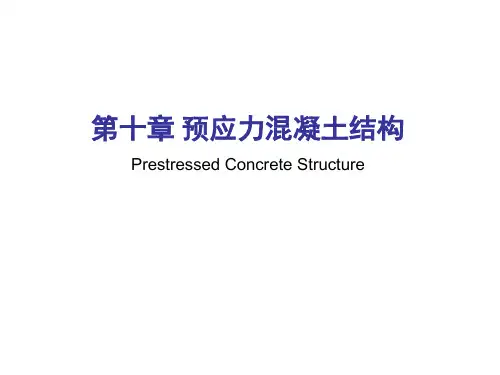
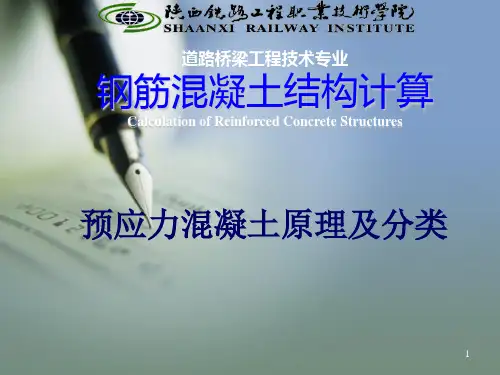
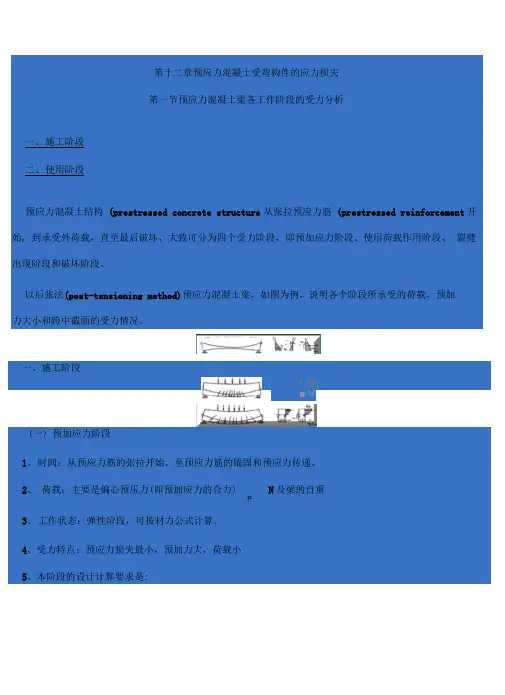
第十二章预应力混凝土受弯构件的应力损失第一节预应力混凝土梁各工作阶段的受力分析一、 施工阶段 二、 使用阶段预应力混凝土结构 (prestressed concrete structure 从张拉预应力筋 (prestressed reinforcement 开始, 到承受外荷载,直至最后破坏,大致可分为四个受力阶段,即预加应力阶段、使用荷载作用阶段、 裂缝出现阶段和破坏阶段。
以后张法(post-tensioning method)预应力混凝土梁,如图为例,说明各个阶段所承受的荷载、预加 力大小和跨中截面的受力情况。
一、施工阶段(一) 预加应力阶段1、 时间:从预应力筋的张拉开始,至预应力筋的锚固和预应力传递。
2、 荷载:主要是偏心预压力(即预加应力的合力)N 及梁的自重P3、 工作状态:弹性阶段,可按材力公式计算。
4、受力特点:预应力损失最小,预加力大,荷载小5、本阶段的设计计算要求是:7 rtf■ V二、钢筋预应力损失值的估算《公桥规》规定,在计算构件截面应力和确定钢筋的控制应力时,应考虑由下列因素引起的六种预应力损失:a、预应力钢筋与管壁之间的摩擦损失cm ;b、锚具变形、钢筋回缩、分块拼装构件的接缝压缩损失C2 ;c、混凝土加热养护时,预应力钢筋与台座之间的温度损失d、混凝土的弹性压缩损失C 14 ;e、预应力钢筋的应力松弛损失c 15 ;f、混凝土的收缩和徐变损失(T 16 o(一)钢筋与管道壁之间的摩擦引起的应力损失1、原因:这种预应力损失出现在后张法构件中。
引起预应力损失的摩擦阻力由两部分组成:一是曲线布置的预应力钢筋,张拉时钢筋对管道内壁的垂直挤压力,导致产生摩阻力,其值随钢筋弯曲角度的总和而增加,这部分阻力较大;二是由于管道位置的偏差和不光滑所造成的,这部分阻力相对小些,取决于钢筋的长度、钢筋与孔道之间的摩擦系数、以及孔道成型的施工质量等。
如图。
2、计算:3、为了减小摩擦阻力损失,一般可采用如下措施:a、采用两端同时张拉;b、进行超张拉。

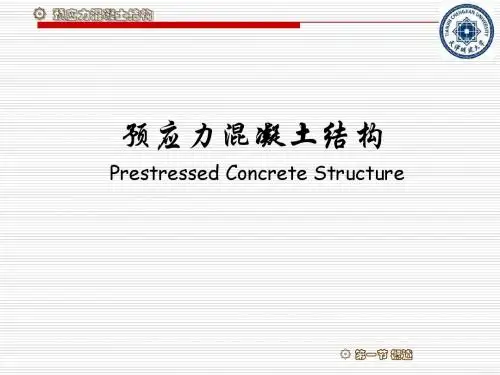
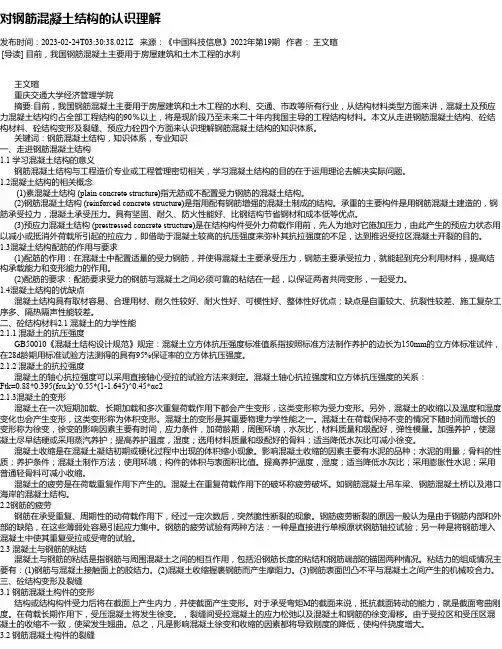
对钢筋混凝土结构的认识理解发布时间:2023-02-24T03:30:38.021Z 来源:《中国科技信息》2022年第19期作者:王文暄[导读] 目前,我国钢筋混凝土主要用于房屋建筑和土木工程的水利王文暄重庆交通大学经济管理学院摘要:目前,我国钢筋混凝土主要用于房屋建筑和土木工程的水利、交通、市政等所有行业,从结构材料类型方面来讲,混凝土及预应力混凝土结构约占全部工程结构的90%以上,将是现阶段乃至未来二十年内我国主导的工程结构材料。
本文从走进钢筋混凝土结构、砼结构材料、砼结构变形及裂缝、预应力砼四个方面来认识理解钢筋混凝土结构的知识体系。
关键词:钢筋混凝土结构,知识体系,专业知识一、走进钢筋混凝土结构1.1 学习混凝土结构的意义钢筋混凝土结构与工程造价专业或工程管理密切相关,学习混凝土结构的目的在于运用理论去解决实际问题。
1.2混凝土结构的相关概念(1)素混凝土结构 (plain concrete structure)指无筋或不配置受力钢筋的混凝土结构。
(2)钢筋混凝土结构 (reinforced concrete structure)是指用配有钢筋增强的混凝土制成的结构。
承重的主要构件是用钢筋混凝土建造的,钢筋承受拉力,混凝土承受压力。
具有坚固、耐久、防火性能好、比钢结构节省钢材和成本低等优点。
(3)预应力混凝土结构 (prestressed concrete structure)是在结构构件受外力荷载作用前,先人为地对它施加压力,由此产生的预应力状态用以减小或抵消外荷载所引起的拉应力,即借助于混凝土较高的抗压强度来弥补其抗拉强度的不足,达到推迟受拉区混凝土开裂的目的。
1.3混凝土结构配筋的作用与要求 (1)配筋的作用:在混凝土中配置适量的受力钢筋,并使得混凝土主要承受压力,钢筋主要承受拉力,就能起到充分利用材料,提高结构承载能力和变形能力的作用。
(2)配筋的要求:配筋要求受力的钢筋与混凝土之间必须可靠的粘结在一起,以保证两者共同变形,一起受力。

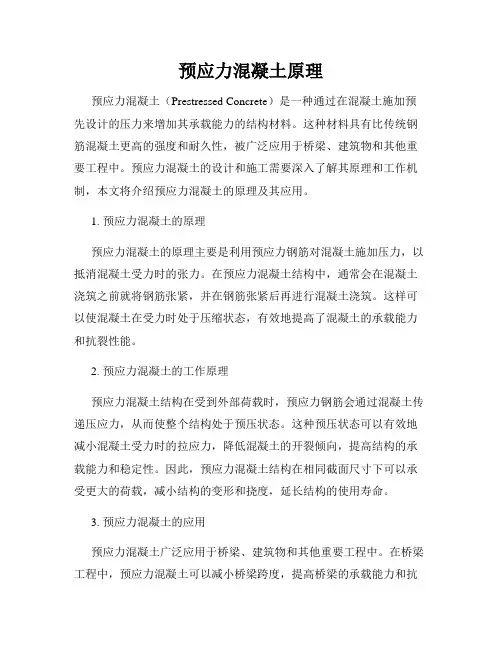
预应力混凝土原理预应力混凝土(Prestressed Concrete)是一种通过在混凝土施加预先设计的压力来增加其承载能力的结构材料。
这种材料具有比传统钢筋混凝土更高的强度和耐久性,被广泛应用于桥梁、建筑物和其他重要工程中。
预应力混凝土的设计和施工需要深入了解其原理和工作机制,本文将介绍预应力混凝土的原理及其应用。
1. 预应力混凝土的原理预应力混凝土的原理主要是利用预应力钢筋对混凝土施加压力,以抵消混凝土受力时的张力。
在预应力混凝土结构中,通常会在混凝土浇筑之前就将钢筋张紧,并在钢筋张紧后再进行混凝土浇筑。
这样可以使混凝土在受力时处于压缩状态,有效地提高了混凝土的承载能力和抗裂性能。
2. 预应力混凝土的工作原理预应力混凝土结构在受到外部荷载时,预应力钢筋会通过混凝土传递压应力,从而使整个结构处于预压状态。
这种预压状态可以有效地减小混凝土受力时的拉应力,降低混凝土的开裂倾向,提高结构的承载能力和稳定性。
因此,预应力混凝土结构在相同截面尺寸下可以承受更大的荷载,减小结构的变形和挠度,延长结构的使用寿命。
3. 预应力混凝土的应用预应力混凝土广泛应用于桥梁、建筑物和其他重要工程中。
在桥梁工程中,预应力混凝土可以减小桥梁跨度,提高桥梁的承载能力和抗震性能;在建筑物工程中,预应力混凝土可以减小柱、梁的截面尺寸,增加空间利用率和美观性。
此外,预应力混凝土还被广泛应用于高层建筑、水利工程、机场跑道等工程中,为工程的安全性和可靠性提供了保障。
总之,预应力混凝土作为一种高性能结构材料,在工程领域有着广泛的应用前景。
通过深入理解预应力混凝土的原理和工作机制,我们可以更好地设计和施工预应力混凝土结构,提高工程的质量和安全性,实现结构的高效能耗和可持续发展。
愿通过不断的技术创新和工艺改进,预应力混凝土在工程领域发挥更大的作用,为建设更加安全、美观、高效的现代化城市做出贡献。
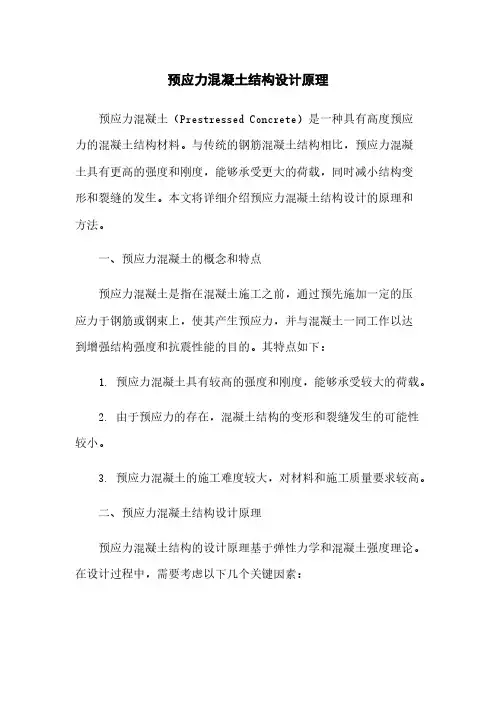
预应力混凝土结构设计原理预应力混凝土(Prestressed Concrete)是一种具有高度预应力的混凝土结构材料。
与传统的钢筋混凝土结构相比,预应力混凝土具有更高的强度和刚度,能够承受更大的荷载,同时减小结构变形和裂缝的发生。
本文将详细介绍预应力混凝土结构设计的原理和方法。
一、预应力混凝土的概念和特点预应力混凝土是指在混凝土施工之前,通过预先施加一定的压应力于钢筋或钢束上,使其产生预应力,并与混凝土一同工作以达到增强结构强度和抗震性能的目的。
其特点如下:1. 预应力混凝土具有较高的强度和刚度,能够承受较大的荷载。
2. 由于预应力的存在,混凝土结构的变形和裂缝发生的可能性较小。
3. 预应力混凝土的施工难度较大,对材料和施工质量要求较高。
二、预应力混凝土结构设计原理预应力混凝土结构的设计原理基于弹性力学和混凝土强度理论。
在设计过程中,需要考虑以下几个关键因素:1. 荷载和荷载组合:根据结构所处的使用环境和设计要求,确定荷载类型和荷载组合,包括恒载、活载和地震荷载等。
2. 结构的几何形状:包括截面形状、跨径长度和构件布置等。
3. 材料特性:包括混凝土和预应力钢材的力学性能和耐久性能等。
4. 预应力方式和力量:根据结构的要求和设计目标,确定适当的预应力方式和施加的预应力力量。
三、预应力混凝土结构设计步骤预应力混凝土结构设计的一般步骤如下:1. 了解结构要求和设计目标。
2. 确定结构的几何形状和荷载要求。
3. 选择合适的预应力方式和力量。
4. 进行结构的受力分析和计算。
5. 设计结构的截面尺寸和预应力布置方式。
6. 进行结构的验算和抗震性能评估。
7. 编制结构施工图纸和技术规范。
8. 进行结构施工和监督。
四、预应力混凝土结构设计的优点和应用领域预应力混凝土结构由于其较高的强度和刚度,广泛应用于工业和民用建筑领域。
其优点包括:1. 结构强度高,能够满足大跨度和高荷载的需求。
2. 结构变形小,使得建筑物使用更加舒适和稳定。
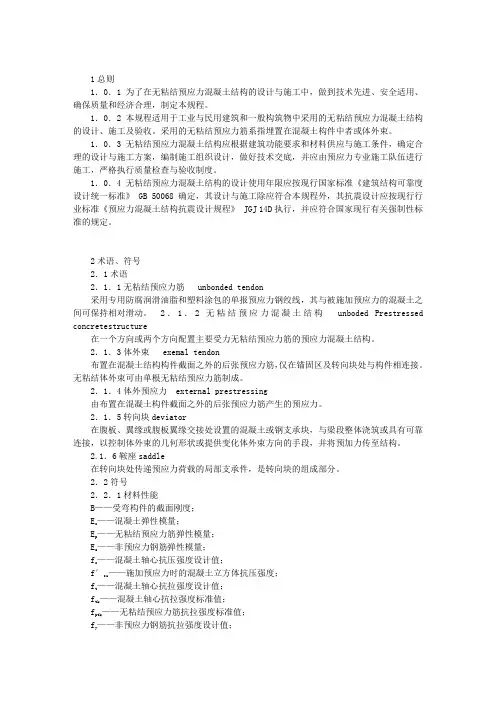
1总则1.0.1为了在无粘结预应力混凝土结构的设计与施工中,做到技术先进、安全适用、确保质量和经济合理,制定本规程。
1.0.2本规程适用于工业与民用建筑和一般构筑物中采用的无粘结预应力混凝土结构的设计、施工及验收。
采用的无粘结预应力筋系指埋置在混凝土构件中者或体外束。
1.0.3无粘结预应力混凝土结构应根据建筑功能要求和材料供应与施工条件,确定合理的设计与施工方案,编制施工组织设计,做好技术交底,并应由预应力专业施工队伍进行施工,严格执行质量检查与验收制度。
1.0.4无粘结预应力混凝土结构的设计使用年限应按现行国家标准《建筑结构可靠度设计统一标准》 GB 50068确定,其设计与施工除应符合本规程外,其抗震设计应按现行行业标准《预应力混凝土结构抗震设计规程》 JGJ 14D执行,并应符合国家现行有关强制性标准的规定。
2术语、符号2.1术语2.1.1无粘结预应力筋 unbonded tendon采用专用防腐润滑油脂和塑料涂包的单报预应力钢绞线,其与被施加预应力的混凝土之间可保持相对滑动。
2.1.2无粘结预应力混凝土结构unboded Prestressed concretestructure在一个方向或两个方向配置主要受力无粘结预应力筋的预应力混凝土结构。
2.1.3体外束 exemal tendon布置在混凝土结构构件截面之外的后张预应力筋,仅在锚固区及转向块处与构件相连接。
无粘结体外束可由单根无粘结预应力筋制成。
2.1.4体外预应力 external prestressing由布置在混凝土构件截面之外的后张预应力筋产生的预应力。
2.1.5转向块deviator在腹板、翼缘或腹板翼缘交接处设置的混凝土或钢支承块,与梁段整体浇筑或具有可靠连接,以控制体外束的几何形状或提供变化体外束方向的手段,并将预加力传至结构。
2.1.6鞍座saddle在转向块处传递预应力荷载的局部支承件,是转向块的组成部分。
2.2符号2.2.1材料性能B——受弯构件的截面刚度;E c——混凝土弹性模量;E p——无粘结预应力筋弹性模量;E s——非预应力钢筋弹性模量;f c——混凝土轴心抗压强度设计值;f′cu——施加预应力时的混凝土立方体抗压强度;f t——混凝土轴心抗拉强度设计值;f tk——混凝土轴心抗拉强度标准值;f ptk——无粘结预应力筋抗拉强度标准值;f y——非预应力钢筋抗拉强度设计值;f yv——钱栓抗拉强度设计值。
2.1 术语第2.1.1条混凝土结构concrete structure以混凝土为主制成的结构,包括素混凝土结构,钢筋混凝土结构和预应力混凝土结构等。
第2.1.2条素混凝土结构plain concrete structure由无筋或不配置受力钢筋的混凝土制成的结构。
第2.1.3条钢筋混凝土结构reinforced concrete structure由配置受力的普通钢筋,钢筋网或钢筋骨架的混凝土制成的结构。
第2.1.4条预应力混凝土结构prestressed concrete structure由配置受力的预应力钢筋通过张拉或其他方法建立预加应力的混凝土制成的结构。
第2.1.5条先张法预应力混凝土结构pretensioned prestressed concrete structure在台座上张拉预应力钢筋后浇筑混凝土,并通过粘结力传递而建立预加应力的混凝土结构。
第2.1.6条后张法预应力混凝土结构post-tensioned prestressed concrete structure在混凝土达到规定强度后,通过张拉预应力钢筋并在结构上锚固而建立预加应力的混凝土结构。
第2.1.7条现浇混凝土结构cast-in-situ concrete structure在现场支模并整体浇筑而成的混凝土结构。
第2.1.8条装配式混凝土结构prefabricated concrete structure由预制混凝土构件或部件通过焊接,螺栓连接等方式装配而成的混凝土结构。
第2.1.9条装配整体式混凝土结构assembled monolithic concrete structure由预制混凝土构件或部件通过钢筋,连接件或施加预应力加以连接并现场浇筑混凝土而形成整体的结构。
第2.1.10条框架结构frame structure由梁和柱以刚接或铰接相连接而构成承重体系的结构。
第2.1.11条剪力墙结构shearwall structure由剪力墙组成的承受竖向和水平作用的结构。
毕业设计(论文)外文文献翻译文献、资料中文题目:预应力混凝土文献、资料英文题目:Prestressed Concrete文献、资料来源:文献、资料发表(出版)日期:院(部):专业:班级:姓名:学号:指导教师:翻译日期: 2017.02.14毕业设计(论文)外文资料翻译外文出处:The Concrete structure附件:1、外文原文;2、外文资料翻译译文。
1、外文资料原文Prestressed ConcreteConcrete is strong in compression, but weak in tension: Its tensile strength varies from 8 to 14 percent of its compressive strength. Due tosuch a Iow tensile capacity, fiexural cracks develop at early stages ofloading. In order to reduce or prevent such cracks from developing, aconcentric or eccentric force is imposed in the longitudinal direction of the structural element. This force prevents the cracks from developing by eliminating or considerably reducing the tensile stresses at thecritical midspan and support sections at service load, thereby raising the bending, shear, and torsional capacities of the sections. The sections are then able to behave elastically, and almost the full capacity of the concrete in compression can be efficiently utilized across the entire depth of the concrete sections when all loads act on the structure.Such an imposed longitudinal force is called a prestressing force,i.e., a compressive force that prestresses the sections along the span ofthe structural elementprior to the application of the transverse gravitydead and live loads or transient horizontal live loads. The type ofprestressing force involved, together with its magnitude, are determined mainly on the basis of the type of system to be constructed and the span length and slenderness desired.~ Since the prestressing force is applied longitudinally along or parallel to the axis of the member, the prestressing principle involved is commonly known as linear prestressing.Circular prestressing, used in liquid containment tanks, pipes,and pressure reactor vessels, essentially follows the same basic principles as does linear prestressing. The circumferential hoop, or "hugging" stress on the cylindrical or spherical structure, neutralizes the tensile stresses at the outer fibers of the curvilinear surface caused by the internal contained pressure.Figure 1.2.1 illustrates, in a basic fashion, the prestressing action in both types of structural systems and the resulting stress response. In(a), the individual concrete blocks act together as a beam due to the large compressive prestressing force P. Although it might appear that the blocks will slip and vertically simulate shear slip failure, in fact they will not because of the longitudinal force P. Similarly, the wooden staves in (c) might appear to be capable of separating as a result of the high internal radial pressure exerted on them. But again, because of the compressive prestress imposed by the metal bands as a form of circular prestressing, they will remain in place.From the preceding discussion, it is plain that permanent stresses in the prestressed structural member are created before the full dead and live loads are applied in order to eliminate or considerably reduce the net tensile stresses caused by these loads. With reinforced concrete,it is assumed that the tensile strength of the concrete is negligible and disregarded. This is because the tensile forces resulting from the bending moments are resisted bythe bond created in the reinforcement process. Cracking and deflection are therefore essentially irrecoverable in reinforced concrete once the member has reached its limit state at service load.The reinforcement in the reinforced concrete member does not exert any force of its own on the member, contrary to the action of prestressing steel. The steel required to produce the prestressing force in the prestressed member actively preloads the member, permitting a relatively high controlled recovery of cracking and deflection. Once the flexural tensile strength of the concrete is exceeded, the prestressed member starts to act like a reinforced concrete element.Prestressed members are shallower in depth than their reinforced concrete counterparts for the same span and loading conditions. In general, the depth of a prestressed concrete member is usually about 65 to 80 percent of the depth of the equivalent reinforced concrete member. Hence, the prestressed member requires less concrete, and,about 20 to 35 percent of the amount of reinforcement. Unfortunately, this saving in material weight is balanced by the higher cost of the higher quality materials needed in prestressing. Also, regardless of the system used, prestressing operations themselves result in an added cost: Formwork is more complex, since the geometry of prestressed sections is usually composed of. flanged sections with thin-webs.In spite of these additional costs, if a large enough number of precast units are manufactured, the difference between at least the initial costs of prestressed and reinforced concrete systems is usually not very large.~ And the indirect long-term savings are quite substantial, because less maintenance is needed; a longer working life is possible due to better quality control of the concrete, and lighter foundations are achieved due to the smaller cumulative weight of the superstructure.Once the beam span of reinforced concrete exceeds 70 to 90 feet (21.3 to 27.4m), the dead weight of the beam becomes excessive, resulting in heavier members and, consequently, greater long-term deflection and cracking. Thus, for larger spans, prestressed concrete becomes mandatory since arches are expensive to construct and do not perform as well due to the severe long-term shrinkage and creep they undergo.~ Very large spans such as segmental bridges or cable-stayed bridges can only be constructed through the use of prestressing.Prestressd concrete is not a new concept, dating back to 1872, when P. H. Jackson, an engineer from California, patented a prestressing system that used a tie rod to construct beams or arches from individual blocks [see Figure 1.2.1 (a)]. After a long lapse of time during which little progress was made because of the unavailability of high-strength steel to overcome prestress losses, R. E. Dill of Alexandria, Nebraska, recognized the effect of the shrinkage and creep (transverse material flow) of concrete on the loss of prestress. He subsequently developed the idea that successive post-tensioning of unbonded rods would compensate for the time-dependent loss of stress in the rods due to the decrease in the length of the member because of creep and shrinkage. In the early 1920s,W. H. Hewett of Minneapolis developed the principles of circular prestressing. He hoop-stressed horizontal reinforcement around walls of concrete tanks through the use of turnbuckles to prevent cracking due to internalliquid pressure, thereby achieving watertightness. Thereafter, prestressing of tanks and pipes developed at an accelerated pace in the United States, with thousands of tanks for water, liquid, and gas storage built and much mileage of prestressed pressure pipe laid in the two to three decades that followed.Linear prestressing continued to develop in Europe and in France, in particular through the ingenuity of Eugene Freyssinet, who proposed in 1926--1928 methods to overcome prestress losses through the use of high-strength and high-ductility steels. In 1940, he introduced thenow well-known and well-accepted Freyssinet system.P. W. Abeles of England introduced and developed the concept of partial prestressing between the 1930s and 1960s. F. Leonhardt of Germany, V. Mikhailov of Russia, and T. Y. Lin of the United States also contributed a great deal to the art and science of the design of prestressed concrete. Lin's load-balancing method deserves particular mention in this regard, as it considerably simplified the design process, particularly in continuous structures. These twentieth-century developments have led to the extensive use of prestressing throughoutthe world, and in the United States in particular.Today, prestressed concrete is used in buildings, underground structures, TV towers, floating storage and offshore structures, power stations, nuclear reactor vessels, and numerous types of bridge systems including segn~ental and cable-stayed bridges, they demonstrate the versatility of the prestressing concept and its all-encompassing application. The success in the development and construction of all these structures has been due in no small measures to the advances in the technology of materials, particularly prestressing steel, and the accumulated knowledge in estimating the short-and long-term losses in the prestressing forces.~2、外文资料翻译译文预应力混凝土混凝土的力学特性是抗压不抗拉:它的抗拉强度是抗压强度的8%一14%。